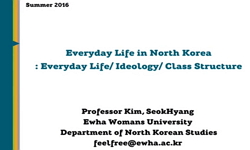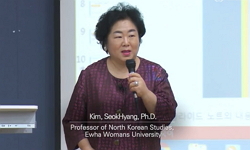Background: Vivax malaria reemerged in the Korean peninsula in 1990s beginning from the western border area and spread across both Koreas rapidly with its peak incidences reported on the early 2000s. There have been few reports on the malaria incidenc...
http://chineseinput.net/에서 pinyin(병음)방식으로 중국어를 변환할 수 있습니다.
변환된 중국어를 복사하여 사용하시면 됩니다.
- 中文 을 입력하시려면 zhongwen을 입력하시고 space를누르시면됩니다.
- 北京 을 입력하시려면 beijing을 입력하시고 space를 누르시면 됩니다.




Malaria Incidence of the Regions Adjacent to the Demilitarized Zone in the Democratic People's Republic of Korea, 2004–2016
한글로보기https://www.riss.kr/link?id=A106362856
- 저자
- 발행기관
- 학술지명
- 권호사항
-
발행연도
2019
-
작성언어
English
- 주제어
-
등재정보
KCI등재,SCI,SCIE,SCOPUS
-
자료형태
학술저널
-
수록면
1-11(11쪽)
-
KCI 피인용횟수
1
- 제공처
-
0
상세조회 -
0
다운로드
부가정보
다국어 초록 (Multilingual Abstract)
Background: Vivax malaria reemerged in the Korean peninsula in 1990s beginning from the western border area and spread across both Koreas rapidly with its peak incidences reported on the early 2000s. There have been few reports on the malaria incidence in the Democratic People's Republic of Korea (North Korea) that provides detailed epidemiological features.
The purpose of this study was to describe the time trends and spatial distribution of malaria in North Korea with comparison to those in South Korean regions across the border.
Methods: The incidence of malaria in each province of North Korea from 2004 to 2016 was estimated based on data from domestic and international health authorities. Consistency of the data was evaluated by calculating the ratio of malaria cases in each province to the total cases each year. We also compared the changes in malaria incidence over time in South and North Korea adjacent to the demilitarized zone.
Results: In North Korea, the incidence of malaria in the three provinces adjacent to the demilitarized zone was the highest (52.1−315.3 per 100,000), followed by Pyeonganbuk-do (14.7−113.5 per 100,000), where railways and road networks were connected to northern China. The incidence of malaria in each province of North Korea reported after 2011 was more consistent than when compared with previous annual data, and there was also a positive correlation between changes in incidence over time when compared with malaria incidence in South Korea (r = 0.855, r = 0.596).
Conclusion: The malaria report of North Korea was relatively consistent in its spatiotemporal tendency since 2011, suggesting improvement of the quality of the surveillance data. The strong correlation between North and South Korean malaria incidence at regional level suggests that collaboration between both sides are essential for the successful elimination of malaria in the Korean peninsula.
참고문헌 (Reference)
1 여인석, "학질에서 말라리아로: 한국 근대 말라리아의 역사(1876-1945)" 대한의사학회 20 (20): 53-82, 2011
2 Voice of America, "WHO says the number of malaria patients in North Korea is about 18,000 in 2009"
3 Ree HI, "Unstable vivax malaria in Korea" 38 (38): 119-138, 2000
4 Cho SY, "Two vivax malaria cases detected in Korea" 32 (32): 281-284, 1994
5 The Korea Centers for Disease Control and Prevention, "The government's report on malaria infection in North Korea"
6 Division of Infectious Disease Control, "The Korea Centers for Disease Control and Prevention. Report on the participation of the technical consultative meeting on malaria in South and North Korea and related countries"
7 World Health Organization, "Synopsis of the world malaria situation, 1979" 56 (56): 145-149, 1981
8 Centers for Disease Control and Prevention (CDC), "Status of public health--Democratic People's Republic of Korea, April 1997" 46 (46): 561-565, 1997
9 Schwekendiek D, "Regional variations in living conditions during the North Korean food crisis of the 1990s" 22 (22): 460-476, 2010
10 Grundy J, "Public health and international partnerships in the Democratic People's Republic of Korea" 12 (12): e1001929-, 2015
1 여인석, "학질에서 말라리아로: 한국 근대 말라리아의 역사(1876-1945)" 대한의사학회 20 (20): 53-82, 2011
2 Voice of America, "WHO says the number of malaria patients in North Korea is about 18,000 in 2009"
3 Ree HI, "Unstable vivax malaria in Korea" 38 (38): 119-138, 2000
4 Cho SY, "Two vivax malaria cases detected in Korea" 32 (32): 281-284, 1994
5 The Korea Centers for Disease Control and Prevention, "The government's report on malaria infection in North Korea"
6 Division of Infectious Disease Control, "The Korea Centers for Disease Control and Prevention. Report on the participation of the technical consultative meeting on malaria in South and North Korea and related countries"
7 World Health Organization, "Synopsis of the world malaria situation, 1979" 56 (56): 145-149, 1981
8 Centers for Disease Control and Prevention (CDC), "Status of public health--Democratic People's Republic of Korea, April 1997" 46 (46): 561-565, 1997
9 Schwekendiek D, "Regional variations in living conditions during the North Korean food crisis of the 1990s" 22 (22): 460-476, 2010
10 Grundy J, "Public health and international partnerships in the Democratic People's Republic of Korea" 12 (12): e1001929-, 2015
11 Shin DH, "Paleopathological considerations on malaria infection in Korea before the 20th century" 2018 : 8516785-, 2018
12 Lee JS, "Outbreak of vivax malaria in areas adjacent to the demilitarized zone, South Korea, 1998" 66 (66): 13-17, 2002
13 Owen-Davies J, "North Korea's public health tragedy" 357 (357): 628-630, 2001
14 Burki T, "North Korea and the global fund" 18 (18): 501-, 2018
15 National Malaria Programme, Ministry of Public Health, "National Malaria Elimination Strategy 2018–2022: Democratic People's Republic of Korea" World Health Organization, Country Office for DPR Korea 2017
16 Pant SD, "Mass primaquine preventive treatment for control of Plasmodium vivax malaria in the Democratic People's Republic of Korea : a country success story" 3 (3): 75-80, 2014
17 Himeno K, "Malaria occurring at Kangnung area, Kangwon-do" 62 (62): 59-66, 1926
18 Paik YH, "Malaria in Korea" 58 (58): 55-66, 1988
19 Hasegawa Y, "Malaria in Korea" 4 (4): 53-69, 1913
20 Hwang JS, "Malaria control project in the DPRK"
21 National Malaria Eradication Service, "Malaria Pre-eradication Programme in Korea, 1961–1965 Progress Report" Ministry of Health and Social Affairs 44-75, 1966
22 Gyeonggi Research Institute, "Inter-Korean Cooperation and Gyeonggi-Do" Gyeonggi Research Institute 1-170, 2016
23 The Korea Centers for Disease Control and Prevention, "Infectious disease portal"
24 The Korea Centers for Disease Control and Prevention, "Infectious Diseases Surveillance Yearbook 2017" The Korea Centers for Disease Control and Prevention 2017
25 Bhatia R, "Food shortages and nutrition in North Korea" 360 (360): s27-28, 2002
26 Ejov M, "External malaria programme review: DPR Korea"
27 Ahmad K, "Explosion in North Korea destroys health facilities" 363 (363): 1447-, 2004
28 Chol PT, "Evaluation of a malaria control project in DPR Korea, 2001–2003" 36 (36): 565-571, 2005
29 Central Bureau of Statistics, "DPR Korea 2008 Population Census National Report" Central Bureau of Statistics 2009
30 Ree HI, "Can malaria be endemic in South Korea?" 30 (30): 397-400, 1998
31 Mercado CE, "An assessment of national surveillance systems for malaria elimination in the Asia Pacific" 16 (16): 127-, 2017
32 Grundy J, "An approach to health system strengthening in the Democratic Peoples Republic of Korea (North Korea)" 24 (24): 113-129, 2009
33 McCurry J, "Aid workers warn of North Korea's forgotten health crisis" 365 (365): 1997-1998, 2005
34 Paik YH, "A note on the epidemiology of Korean vivax malaria" 6 (6): 37-43, 1963
35 Shin-HyeongCHO, "A mark-release-recapture experiment with Anopheles sinensis in the northern part of Gyeonggi-do, Korea" 대한기생충학ㆍ열대의학회 40 (40): 139-148, 2002
동일학술지(권/호) 다른 논문
-
- 대한의학회
- 김병섭
- 2019
- KCI등재,SCI,SCIE,SCOPUS
-
- 대한의학회
- 염준섭
- 2019
- KCI등재,SCI,SCIE,SCOPUS
-
- 대한의학회
- 장민욱
- 2019
- KCI등재,SCI,SCIE,SCOPUS
-
On the Recovery after Stroke: When and What Should We Focus on?
- 대한의학회
- 임재성
- 2019
- KCI등재,SCI,SCIE,SCOPUS
분석정보
인용정보 인용지수 설명보기
학술지 이력
| 연월일 | 이력구분 | 이력상세 | 등재구분 |
|---|---|---|---|
| 2023 | 평가예정 | 해외DB학술지평가 신청대상 (해외등재 학술지 평가) | |
| 2020-01-01 | 평가 | 등재학술지 유지 (해외등재 학술지 평가) |  |
| 2011-01-01 | 평가 | 등재학술지 유지 (등재유지) |  |
| 2009-01-01 | 평가 | 등재학술지 유지 (등재유지) |  |
| 2005-01-01 | 평가 | SCI 등재 (등재유지) |  |
| 2002-01-01 | 평가 | 등재학술지 선정 (등재후보2차) |  |
| 1999-07-01 | 평가 | 등재후보학술지 선정 (신규평가) |  |
학술지 인용정보
| 기준연도 | WOS-KCI 통합IF(2년) | KCIF(2년) | KCIF(3년) |
|---|---|---|---|
| 2016 | 1.48 | 0.37 | 1.06 |
| KCIF(4년) | KCIF(5년) | 중심성지수(3년) | 즉시성지수 |
| 0.85 | 0.75 | 0.691 | 0.11 |




 KCI
KCI






